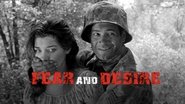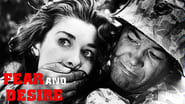Dario Vaccaro
Stanley Kubrick's first feature film was thought lost for many years, but fortunately a copy has been restored and now anyone can watch the first work by maybe the greatest director of all time. Sure, "Fear and Desire" is no masterpiece as Kubrick's late works, not even close, but it still manages to somehow show the brilliance that surrounds the director's works. Set in a metaphoric place as the narrator urges us to know (and yes, that's the main problem of the film: it's too explanatory, something Kubrick will grow extremely away from), representing any war and not one in particular, showing how the event of falling into the enemy lines affects four soldiers, leading one to madness, another to the search for glory and so on. Although very heavily expository, the writing is not as bad as many (including the director himself!) say: the concepts are smart, but surely too stuffed into an hour's film. What I really think should be praised is the powerful idea of using the same actors to perform both sides of the conflict, building up an unsettling sequence close to the end of the movie, which also stands to mean that both sides of a war fight for the same values turned upside down.Obviously, the true highlight of the film is the man behind the camera, with beautiful shots and careful cinematography. The kiddo was already off to a great start.
sol-
Trapped behind enemy lines, the stress of the situation has varying impacts on four soldiers in this existential war movie from Stanley Kubrick. The film marked the great director's feature debut, and poorly received at the time, Kubrick subsequently tried to suppress it, citing the film as the work of an amateur. This controversy has lead to the film acquiring a mixed reputation over the years, but it is a far more accomplished motion picture than one might expect. While not as stylistic and innovatively shot as 'Killer's Kiss', it actually spins a more engaging narrative, focusing on war from a psychological standpoint with memorable lines such as "enemies do not exist ... unless we call them into being". In an effective touch, Kubrick also lets the characters' narrated thoughts aloud overlap at certain points, and with the way the characters discuss and debate war, Samuel Fuller's superb 1950s war movies frequently come to mind. The film's biggest weakness is the acting. Virginia Leith is superb in a brief turn in which her close-up facial expressions convey more than words possibly could, but everyone else is uneven at best with dialogue delivery sometimes stilted. A renowned perfectionist, it is no surprise that Kubrick was dissatisfied with certain elements of the film, but had he not disowned it, it is unlikely that it would be as poorly received at it often is these days. The choice to not specify the actual war or any nationalities provides the story with a welcome universal quality that resonates strongly considering all the other wars that have occurred since 1953.
JoeKulik
The reason that this film got such a poor reception from American movie-goers in 1953 is because, in my opinion, they were incapable of understanding it. Fear And Desire in 1953, would have had much greater commercial success in Continental Europe, especially in France. The Hollywood saturated American audiences of 1953 were conditioned to expect a much different "war movie" than Fear And Desire. European audiences would have immediately recognized it for what is truly is, an Art Film.This film has high artistic merit The cinematography and editing are excellent. The use of montage in this film is very effective.The very small cast of carefully selected and well crafted distinct personality types makes for tight interaction patterns with great symbolic significance.Overall, I'd call this an Existential film that reflects on many aspects of the human condition. That it is superficially set in a war context is only a theatrical ploy against which is investigated the deeper issues concerning human existence in general.The occasional "silent monologue" of the various characters, representing their innermost, most intimate thoughts is an effective plumb into the personality and the life situation of a particular character at a given point in the story line.Although three of the four stranded soldiers are dressed in combat uniforms, all four appear to be "green" and unaccustomed to the realities of combat situations. This combat naivete accentuates their emotional and visceral reactions to the situations in the film where they have to kill enemy soldiers and in their interaction with the peasant girl that they capture.That the viewer is told by the narrator at the very beginning this "war film" that the circumstances regarding the nations involved in the war and the specifics of the theater of this war in which this film takes place are rather "anonymous" and completely unspecified highlights the fact that this film is not at all about actual war itself. The "war" in this film is symbolic of the "war" that we all must navigate through our individual- lives as we traverse the path of Self and Other.
Dalbert Pringle
Fear And Desire (from 1953) is the low-budget, first feature-film directed by legendary movie-maker, Stanley Kubrick, who was but a budding, young film student at the time.Containing some striking camera-work and intense character interaction, this marginally violent War picture tells the tale of 4 soldiers who, after their plane crash-lands, find themselves stranded in a forested region behind the lines of an unnamed enemy in an unidentified country.In order to rejoin their unit, these 4 G.I.s must cautiously make their way downriver without being detected by their foe.Before embarking on their treacherous journey, these tired and weary young men must formulate a workable plan to locate the enemy's headquarters and, thus, assassinate its commanding officer.Filmed in stark b&w, this somewhat intriguing picture has a brief running time of only 60 minutes.







